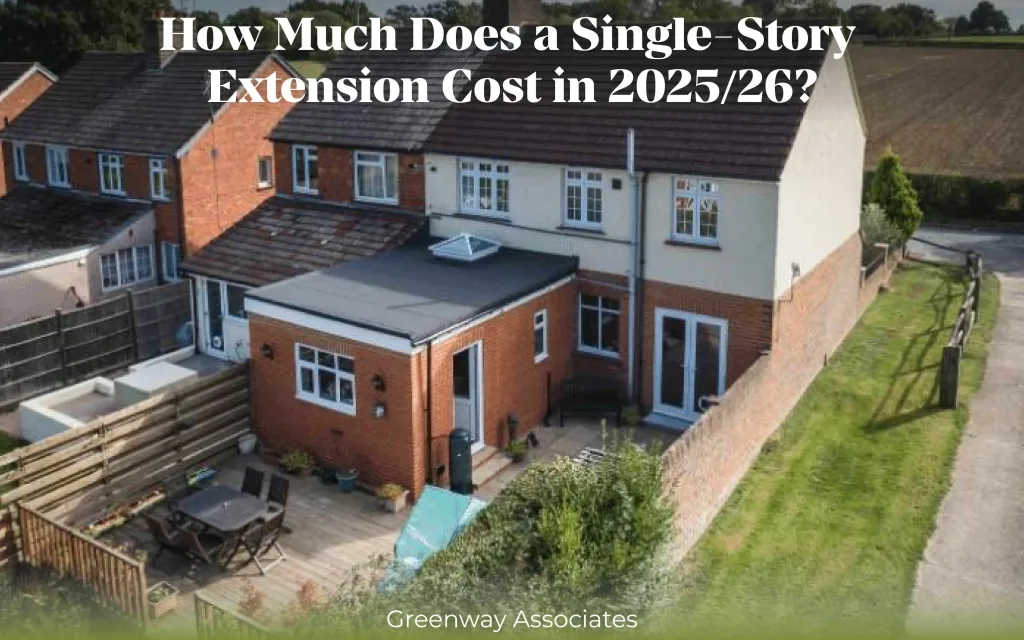Picture this: Sarah from Manchester had been squeezing her growing family into a cramped Victorian terrace for years. Every morning felt like a game of Tetris—dodging around the breakfast table whilst her husband tried to make coffee in their galley kitchen. Sound familiar? By December 2024, she’d transformed her home with a stunning single storey rear extension costing £42,000, creating an open-plan kitchen-diner that’s become the heart of her family life. Her story mirrors that of thousands of UK homeowners discovering that single storey extensions offer the most cost-effective path to the space they desperately need. And you may be thinking, “Well, how much does a single storey extension cost?”
With UK property prices continuing their relentless climb—averaging £287,000 in 2024 according to the ONS—moving house simply isn’t viable for most families. Instead, savvy homeowners are choosing to extend, and single storey extensions have emerged as the clear winner for maximising space whilst minimising stress and expense.

How much does a single storey extension cost
Table of Contents
- Understanding Single Storey Extension Costs in 2025
- Do You Need Planning Permission for Single Storey Extensions?
- Permitted Development Rights Explained
- Building Regulations Requirements
- Affordable Single Storey Extension Ideas
- Single Storey Rear Extension Designs
- Side Extension Possibilities
- Cost Breakdown Per Square Metre
- How Long Does Construction Take?
- Maximising Your Extension Budget
- Common Mistakes to Avoid
- Future-Proofing Your Extension
Understanding Single Storey Extension Costs in 2025
The single storey extension cost UK 2025 landscape has shifted significantly since 2024, with material costs stabilising after the post-pandemic surge. Currently, you can expect to invest between £1,800 and £2,800 per square metre for a quality single storey extension, depending on your location and specification choices.
Regional Cost Variations:
- London & South East: £2,500-£3,200 per m²
- Manchester, Birmingham, Leeds: £2,000-£2,500 per m²
- Scotland, Wales, North East: £1,800-£2,200 per m²
The average cost of single storey extension UK 2024 data shows that most homeowners spent between £35,000 and £65,000 on their projects. However, these figures can be misleading without context. A basic 20m² rear extension in Yorkshire might cost £40,000, whilst the same space in Kensington could reach £80,000.
What Influences Your Costs:
| Cost Factor | Budget Impact | Example |
|---|---|---|
| Foundation requirements | 15-25% of total cost | Complex ground conditions add £8,000-£15,000 |
| Roof specification | 10-20% of total cost | Flat roof vs pitched roof difference: £3,000-£8,000 |
| Windows & doors | 12-18% of total cost | Standard vs bi-fold doors: £2,000-£12,000 difference |
| Internal finishes | 20-35% of total cost | Basic vs luxury kitchen: £15,000-£40,000 difference |
Do You Need Planning Permission for Single Storey Extensions?
The question “do I need planning permission for a single storey extension” keeps many homeowners awake at night, but the answer is often more encouraging than you might expect. Under current permitted development rights for single-story extensions 2024, many projects can proceed without formal planning permission.
Permitted Development Limits (England):
- Rear extensions: Up to 6 metres for detached houses, 3 metres for terraced/semi-detached
- Height restrictions: Maximum 4 metres to ridge, 3 metres to eaves
- Coverage: No more than 50% of original garden area
When You DO Need Planning Permission:
- Conservation areas – Special rules apply
- Listed buildings – Always requires consent
- Article 4 directions – Local restrictions in place
- Exceeding permitted development limits
- Forward-facing extensions – Rarely permitted under PD
The Prior Notification Process: Even under permitted development, extensions over certain sizes require prior notification. This involves:
- Submitting basic plans to your local authority
- £96 fee (2025 rates)
- 42-day determination period
- Neighbours’ consultation opportunity
Sarah’s Manchester extension fell comfortably within permitted development rights, saving her £1,500 in planning fees and 8-12 weeks in waiting time.
Permitted Development Rights Explained
Permitted development rights for single-story extensions 2024 have been extended several times since their introduction, reflecting government recognition that families need space to grow. These rights are designed to encourage sensible home improvements whilst protecting neighbours’ amenity.
Key Permitted Development Rules:
Rear Extensions
- Single storey: 6m (detached), 3m (terraced/semi-detached)
- Must not extend beyond rear wall of original house by more than these limits
- Cannot exceed 4m in height
- Cannot cover more than 50% of original curtilage
Side Extensions
- Single storey only under PD
- Cannot extend beyond front wall
- Maximum height of 4m
- Cannot be wider than half the original house width
Important Considerations: The single storey extension planning permission requirements become mandatory if you’re in a conservation area, where permitted development rights are often restricted or removed entirely. Always check with your local planning authority before assuming your project qualifies.
Building Regulations Requirements
Whilst planning permission focuses on the visual and spatial impact of your extension, single storey extension building regulations UK govern safety, energy efficiency, and structural integrity. Every single storey extension must comply with building regulations, regardless of size.
Key Building Regulations Areas:
Structure (Part A)
- Foundation design and specification
- Structural calculations for load-bearing elements
- Wall construction and insulation requirements
Fire Safety (Part B)
- Escape route provisions
- Fire-resistant materials
- Smoke alarm integration
Energy Efficiency (Part L)
- U-values for walls, roof, and floors
- Window and door thermal performance
- Heating system integration
Accessibility (Part M)
- Door widths and thresholds
- Level access where possible
- Step-free access considerations
The Building Regulations Process:
- Submit application with detailed drawings and specifications
- Pay fees (typically £150-£400 depending on extension size)
- Receive approval (usually within 5-8 weeks)
- Book inspections at key construction stages
- Receive completion certificate
Most homeowners work with their builder or architect to handle building regulations submissions. The cost is typically included in professional fees, but budget £800-£1,500 if managing this separately.
Affordable Single Storey Extension Ideas
Creating affordable single storey house extension ideas doesn’t mean compromising on style or functionality. Some of the most successful projects we’ve seen have modest budgets but clever design thinking.
Budget-Friendly Design Strategies:
Simple Rectangular Extensions
The most affordable single storey rear extension ideas often involve simple, rectangular shapes that minimise complex construction details. A 6m x 4m rear extension with standard finishes typically costs £45,000-£55,000 outside London.
Flat Roof Construction
Whilst pitched roofs look attractive, flat roofs with modern EPDM membranes cost 20-30% less and can incorporate roof lights for natural light. Modern flat roofs, when properly detailed, offer 20+ year lifespans.
Standard Materials & Fittings
- Walls: Blockwork with render rather than expensive facing brick
- Windows: Standard double-glazed units rather than triple-glazed
- Doors: Quality UPVC bi-folds instead of aluminium
- Flooring: Polished concrete or quality laminate rather than stone
Real Example – Budget Extension: Tom in Leeds created a 20m² kitchen extension for just £38,000 by:
- Using a simple rectangular design
- Choosing a flat roof with two roof lights
- Installing standard UPVC bi-fold doors
- Opting for a painted render external finish
- Using polished concrete flooring throughout
Single Storey Rear Extension Designs
Single storey rear extension projects offer the greatest potential for transformation, creating seamless connections between indoor and outdoor living spaces. The single storey rear extension cost per m² UK averages £2,200, making this one of the most cost-effective ways to add value to your property.
Popular Rear Extension Layouts:
L-Shaped Extensions
Perfect for corner plots or when you want to wrap around existing structures. L-shaped designs can incorporate:
- Open-plan kitchen-dining areas
- Separate utility zones
- Direct garden access from multiple points
- Enhanced natural light from two aspects
Full-Width Extensions
Spanning the entire width of your house, these extensions create impressive open-plan living spaces. Typical costs range from £50,000-£80,000 depending on size and specification.
Wrap-Around Extensions
Combining rear and side extensions, wrap-around designs maximise space but require careful planning to ensure neighbour consultation under permitted development rules.
Design Features That Add Value:
| Feature | Cost Addition | Value Added |
|---|---|---|
| Bi-fold doors | £3,000-£8,000 | 5-8% property value |
| Roof lights | £800-£2,000 each | 3-5% property value |
| Underfloor heating | £2,500-£4,000 | 2-4% property value |
| Kitchen island | £3,000-£12,000 | 4-7% property value |
Side Extension Possibilities
Single storey side extension projects work particularly well for semi-detached and detached properties with adequate side access. These extensions can provide:
Utility & Storage Solutions
- Dedicated laundry areas
- Boot rooms and coat storage
- Pantry and additional kitchen storage
- Home office spaces
Additional Reception Rooms
- Extended living areas
- Home offices or studies
- Playrooms or family spaces
- Guest bedrooms with en-suite facilities
Side Extension Considerations: The single storey side extension building regulations UK requirements focus heavily on:
- Boundary proximity – Usually requiring 1m minimum from boundaries
- Neighbour notification – Formal consultation under permitted development
- Access maintenance – Ensuring continued emergency access where required
Average costs for side extensions range from £35,000-£60,000, depending on size and internal specifications.
Cost Breakdown Per Square Metre
Understanding how much does a single-story extension cost in the UK requires breaking down costs into constituent elements. This transparency helps you make informed decisions about where to invest your budget.
Typical Cost Breakdown (per m²):
| Element | Cost Range | Percentage of Total |
|---|---|---|
| Foundations & Groundwork | £300-£500 | 15-20% |
| Structure & Walls | £450-£650 | 25-30% |
| Roof Construction | £280-£420 | 12-18% |
| Windows & External Doors | £200-£400 | 10-15% |
| Internal Finishes | £350-£600 | 18-25% |
| Electrical & Plumbing | £180-£280 | 8-12% |
| Professional Fees | £150-£250 | 8-12% |
Regional Variations Impact: London premiums typically add 25-40% to these base costs, whilst Scotland and Northern England might see 10-15% reductions. Labour costs represent 40-50% of total project costs, explaining much of the regional variation.
Hidden Costs to Consider:
- Ground conditions – Poor ground can add £5,000-£15,000
- Asbestos surveys – Required for pre-1980s properties (£400-£800)
- Party wall agreements – If affecting neighbours (£1,500-£3,000)
- Temporary accommodation – If kitchen unusable (£200-£400/week)
How Long Does Construction Take?
The question “how long does a single storey extension take to build” depends significantly on project complexity and weather conditions. Most single storey extensions follow this timeline:
Typical Construction Schedule:
Weeks 1-2: Groundwork & Foundations
- Site preparation and excavation
- Foundation concrete and curing time
- Drainage connections
- Weather impact: High – winter delays common
Weeks 3-4: Structure & Walls
- Blockwork construction
- Internal walls and partitions
- Window and door installation
- Weather impact: Medium – some weather protection possible
Weeks 5-6: Roof & Weatherproofing
- Roof structure and covering
- External render or cladding
- Final weatherproofing
- Weather impact: High – delays possible in wet weather
Weeks 7-8: Internal Fit-Out
- Electrical and plumbing first fix
- Insulation and plasterboard
- Plastering and decoration
- Weather impact: Low – internal work weather-protected
Weeks 9-10: Final Finishes
- Kitchen installation
- Flooring and final electrical/plumbing
- External works and landscaping
- Final inspections and snagging
Factors Affecting Timeline:
- Ground conditions – Poor ground adds 1-3 weeks
- Planning delays – If required, adds 8-12 weeks upfront
- Material availability – Some items may need ordering well in advance
- Weather conditions – Winter builds often take 20-30% longer
Maximising Your Extension Budget
Smart homeowners understand that cheap single-story extension ideas to maximise space aren’t about cutting corners—they’re about making intelligent choices that deliver maximum impact for minimum spend.
Value Engineering Strategies:
Timing Your Project
- Best times: April-September for weather advantages
- Avoid: December-February when weather delays are common
- Consider: Booking builders during quiet periods for better rates
Material Choices That Matter
High-Impact, Low-Cost Upgrades:
- Polished concrete floors – Industrial chic for £60-£80/m²
- Exposed ceiling beams – Character feature that reduces ceiling costs
- Roof lights instead of dormers – Natural light for £800 vs £4,000+
- Painted blockwork – Modern finish that saves on render costs
Where NOT to Compromise:
- Foundation and structural work – Future problems cost exponentially more
- Damp-proofing and insulation – Essential for long-term comfort
- Electrical installation – Safety and future-proofing critical
- Window and door quality – Security and energy efficiency matter
DIY Opportunities
Skilled DIY enthusiasts can reduce costs by:
- Decoration and painting – Save £2,000-£5,000
- Basic landscaping – Save £1,500-£3,000
- Simple internal fittings – Save £1,000-£2,000
Professional Tasks Only:
- Structural work and foundations
- Electrical installations
- Gas and plumbing work
- Building control submissions
Common Mistakes to Avoid
After reviewing hundreds of single storey extension projects, certain mistakes appear repeatedly. Learning from others’ experiences can save you thousands of pounds and months of frustration.
Planning & Design Mistakes:
Underestimating Total Costs
Many homeowners focus solely on construction costs, forgetting:
- Professional fees (10-15% of build cost)
- Temporary kitchen facilities (£2,000-£5,000)
- Garden reinstatement (£3,000-£8,000)
- Furniture and fittings (10-20% of build cost)
Inadequate Natural Light Planning
Single storey extensions can feel dark without proper light planning:
- Solution: Plan for 20% of floor area in glazing
- Roof lights: Essential for deep extensions
- Light wells: Consider for ground floor rooms that lose windows
Ignoring Neighbour Relations
Poor communication with neighbours causes:
- Planning objections that delay projects
- Ongoing disputes affecting property values
- Legal challenges to permitted development rights
Construction Phase Mistakes:
Inadequate Contractor Vetting
Always verify:
- Insurance coverage (minimum £2 million public liability)
- Recent references from similar projects
- Financial stability through credit checks
- Trade certifications for gas, electrical work
Change Orders During Construction
Every change during construction costs 2-3x more than planning properly upfront:
- Electrical additions: £150/point vs £50/point if planned
- Plumbing changes: £300/modification vs £100 if planned
- Window upgrades: 50% premium if changed during construction
Future-Proofing Your Extension
Modern single storey house extension designs UK increasingly focus on adaptability and future needs. Today’s extension should serve your family for decades, not just current requirements.
Technology Integration:
- Electric vehicle charging – Install 32A supply for future EV
- Smart home pre-wiring – CAT6 data cables throughout
- Solar panel readiness – Ensure roof structure can support panels
- Heat pump compatibility – Design heating system for future upgrades
Lifestyle Adaptations:
- Flexible spaces that can adapt as children grow
- Accessibility considerations for aging in place
- Home working facilities – Dedicated office spaces increasingly valuable
- Multi-generational living – Potential for independent access
Environmental Future-Proofing: Modern building regulations increasingly demand:
- Enhanced insulation standards – Exceed minimum requirements
- Renewable energy readiness – PV and battery storage capabilities
- Sustainable material choices – Low embodied carbon options
- Water efficiency measures – Rainwater harvesting potential
Investment Protection: Your extension should enhance property value long-term:
- Timeless design choices over trendy features
- Quality materials that age well
- Generous proportions that feel spacious
- Garden integration that enhances outdoor living
Transform Your Home with Confidence
Single storey extensions represent the sweet spot of home improvement—delivering maximum space and value enhancement whilst minimising complexity and cost. Whether you’re creating the kitchen-diner of your dreams or adding essential family space, the key lies in thorough planning, realistic budgeting, and working with experienced professionals.
Remember Sarah from our opening story? Her £42,000 investment not only solved her family’s space problems but added an estimated £65,000 to her property value. More importantly, it created the family hub she’d always wanted—a space where morning chaos transformed into cherished family time.
Your Next Steps:
- Define your requirements – What space do you actually need?
- Check planning status – Confirm your permitted development rights
- Get multiple quotes – Compare at least 3 detailed proposals
- Plan for contingencies – Budget 10-15% extra for unexpected costs
- Choose your timing – Book builders well in advance
Ready to Start Your Extension Journey?
Don’t let another cramped morning convince you that your current space is “good enough.” With single storey extension costs UK 2025 remaining competitive and permitted development rights more generous than ever, there’s never been a better time to create the home your family deserves.
Contact our extension specialists today for a free consultation and discover how your extension dreams can become reality. Transform your space, transform your life—it’s time to stop wishing and start building.
Have questions about planning permission, building regulations, or design ideas? Leave a comment below and our experts will provide personalised advice for your specific situation.


